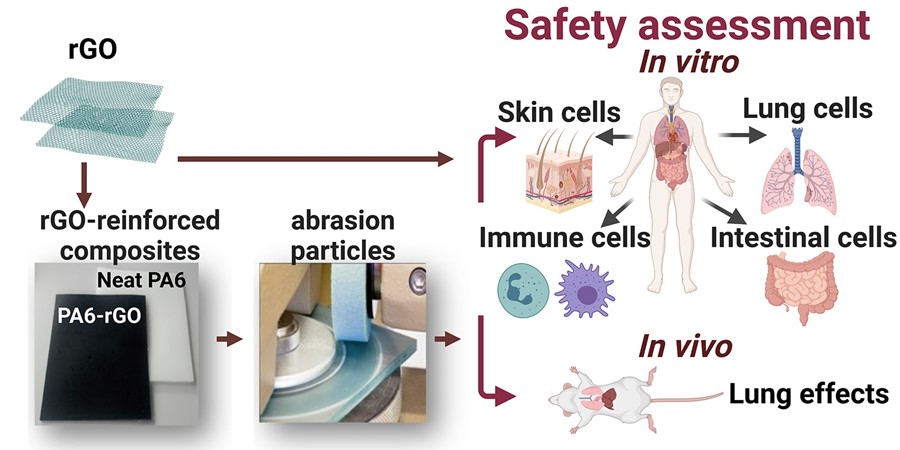Graphene composites found safe to use
Graphene Flagship researchers discovered reduced graphene oxide particles released from plastic composites after abrasion induce negligible health effects in safety analyses
The release of reduced graphene oxide (RGO) from an industrial thermoplastic composite causes minimal effects on human cells and the mouse respiratory system, according to a new multidisciplinary study of the Graphene Flagship.
Graphene-related materials (GRMs) are often used as fillers to reinforce polymers. Small concentrations of up to five weight percent GRMs can significantly enhance the strength, electrical conductivity and thermal transport of composites for a variety of applications. However, being a relatively new set of materials, graphene and GRMs need to be carefully assessed to identify potential adverse effects prior to commercialisation.
In this study, a large interdisciplinary team of engineers and scientists from Graphene Flagship Partner institutions* prepared a composite of polyamide 6 (PA6, also known as Nylon-6) – a thermoplastic polymer used in several sectors such as automotive and sports equipment – with 2.5% RGO. Then they turned this composite into dust via mechanical abrasion, mimicking further processing or end-of-life scenarios, and creating particles with an average diameter of 1.91 μm for RGO-PA6 or 3.16 μm with pure PA6.
The Graphene Flagship researchers analysed the effects of PA6-RGO and PA6 particles and compared them with RGO particles in the most likely exposure routes: they used cell-based models representing human lungs, the gastrointestinal tract (GI), the skin and the immune system. The researchers found only limited acute responses after exposure to RGO-PA6 in the different cell-based models. Only pure RGO particles induced substantial adverse effects, in particular in macrophages, a type of immune cells.
Since inhalation of airborne materials is a key occupational concern, the team conducted a study on the pulmonary effects of these particles in mice. In agreement with the data on cells, PA6-RGO particles induced a modest and transient pulmonary inflammation in mice. Overall, this comprehensive study suggests a likely low risk to human health at acute exposure conditions of RGO-PA6. However, further studies would be required to assess chronic effects or impact on patients suffering from chronic obstructive pulmonary disease (COPD) or asthma.
“We aim to anticipate the ‘what if?’ scenario prior to the broad use of these emerging materials to avoid future social and economic drawbacks,” says Peter Wick from Graphene Flagship Partner Empa in Switzerland. “We anticipated questions, which will become relevant for the 'Chemicals Strategy for sustainability towards a toxic-free environment' of the European Commission, facilitating the safe and sustainable use of GRM-reinforced materials. This was only possible thanks to a multidisciplinary team of experts in polymers, graphene and nanosafety, favoured by the Graphene Flagship ecosystem.”
Andrea C. Ferrari, Science and Technology Officer of the Graphene Flagship, adds: “This comprehensive study of possible toxicity of graphene-polymer composite fragments highlights the central role that health and safety plays in the Graphene Flagship since its very beginning. When these composites are processed into industrial parts, one needs to seriously consider the possible health implications due to emitted/abraded particles. It is reassuring to see this study shows negligible effects, thus confirming the viability of graphene for mass applications.”
*Affiliations (Graphene Flagship Partners):
- Empa (Swiss Federal Laboratories for Materials Science and Technology), Switzerland
- University of Trieste, Italy
- Karolinska Institute, Sweden
- CNRS, France
- Avanzare Innovacion Tecnologica, Spain
- Instituto de Tecnologías Químicas de La Rioja (InterQuímica), Spain
- University of Manchester, United Kingdom
- Foundation of Research and Technology-Hellas (FORTH/ICE-HT), Greece
- Catalan Institute of Nanoscience and Nanotechnology (ICN2), Spain
- Asociacion Centre de Investigacion Cooperativaen Biomateriales – CIC biomaGUNE, Spain
Reference
Chortarea, Savvina, et al. "Hazard Assessment of Abraded Thermoplastic Composites Reinforced with Reduced Graphene Oxide." Journal of Hazardous Materials (2022): 129053. https://www.sciencedirect.com/science/article/pii/S0304389422008421

Graphene Flagship researchers analysed the effect of particles derived from polyamide reinforced with reduced graphene oxide on human cells and mice.




